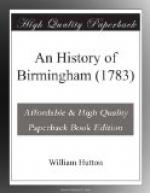After the extinction of the Stuart race, who bore an invincible hatred to presbyterianism, the dissenters from the establishment procured a licence for a meeting at the bottom of Digbeth, which yet bears the name of Meeting-house-yard. Here the rigid sons of worship paid a weekly attendance. The place is now a work-shop: The sound of the pulpit is changed into that of the bellows: Instead of an impression upon the heart, it is now stamped upon the button. The visitants used to appear in a variety of colours, but now always in black.
[Illustration: St. Paul’s Chapel.]
[Illustration: New Meeting.]
[Illustration: Old Meeting.]
Another was erected in the reign of King William, now denominated The Old Meeting, and from whence the street in which it stands derives a name. This is large, and much attended.
Pastor, the Rev. Radcliff Scoldfield.
NEW MEETING.
Erected in the year 1730, at which time that in Digbeth went into disuse. This is in a stile of elegance, and has few equals. The Rev. Samuel Blyth, and the Rev. William Hawkes preside over it.
In December 1780, Mr. Hawkes declining the pastoral care, the congregation judiciously turned their thoughts towards the celebrated Doctor Priestley, F.R.S. one of the first philosophers of the age; whose merit seems obvious to every eye but his own.
CARR’s LANE MEETING.
A scion of the Old Meeting, transplanted in 1748—The building cost about 700_l_. This society hath been favoured with two donations; one the interest of 800_l_. by the will of John England, in 1771: The other Scott’s Trust, mentioned in another part.
This residence of divine light is totally eclipsed, by being surrounded with about forty families of paupers, crouded almost within the compass of a giant’s span, which amply furnish the congregation with noise, smoak, dirt and dispute. If the place itself is the road to heaven, the stranger would imagine, that the road to the place led to something worse: The words, Strait is the gate, and narrow is the way, are here literally verified.—Pastor, the Rev. John Punfield.
BAPTIST MEETING.
Founded in Cannon-street, 1738. This hill of Zion is also hid from the public eye, but situated in a purer air.—The minister was the late Rev. James Turner.
Some trifling differences arising in the congregation, to which the human mind is everlastingly prone, caused discontent: Individuals began to sting each other, which in 1745, produced a swarm.
The destitute wanderers therefore, erected for themselves a small cell in Freeman-street, where they hived in expectation of harmony. Over this little society of separatists presided a journeyman woolcomber: What elevation he bore in the comb-shop, during six days of the week, history is silent; but having the good fortune to procure a black coat and a white wig, he figured on the seventh with parsonic elegance.




